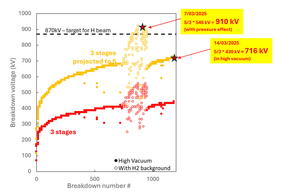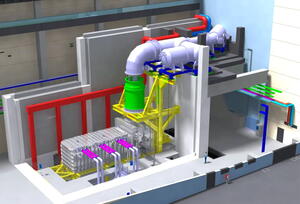A successful round of tests for MITICA
The recent “high-voltage holding in vacuum” tests on MITICA—the full-size prototype of ITER’s heating neutral beam injector—mark a crucial step in advancing ITER's neutral beam heating system.
The recent test campaign on MITICA successfully demonstrated the system’s ability to maintain high voltage in a vacuum environment, reaching the expected voltage-holding capabilities. Due to the unavailability of the final power supply system—set to arrive at the ITER Neutral Beam Test Facility in Padau, Italy, in the coming weeks—a provisional testing generator was used, capable of optimizing the voltage rise on three out of five acceleration stages.
The best value obtained, 430 kV in high vacuum on three stages, corresponds to 710 kV on the full set of five stages, surpassing the target of 700 kV established in the ITER research plan for the end of MITICA’s first campaign, planned in 2027.
Moreover, to investigate all relevant operating conditions, hydrogen gas was injected into the vessel, scanning pressure values between 30 and 50 mPa—typical for MITICA (and ITER heating neutral beam) operation. Under these conditions, the system maintained a maximum voltage of 546 kV on three stages, corresponding to a projected 910 kV across the full configuration. This exceeds the maximum operation voltage required in hydrogen at full performance (870 kV).
Both results reported were also confirmed with additional pulses where the voltage holding was kept successfully for more than an hour—the maximum pulse length foreseen in ITER operation.
It should be noted that these tests were carried out without the MITICA beam source, which is scheduled for delivery this autumn. Instead, an electrostatic full-scale mock-up, designed to replicate the beam source’s electrostatic behaviour, was used. Supplied by Italian manufacturer Fantini Sud SpA, this mock-up was installed inside the MITICA vacuum vessel to study the high-voltage behaviour of the test bed and identify potential issues and challenges before integrating the complete injector system. In particular, it allowed for the testing of an electrostatic shield—connected to the 600 kV acceleration stage and designed to match the 600 kV equipotential surface—which provided the improved voltage holding compared to the previous, unshielded design.
The success of these tests confirms MITICA’s readiness for further testing and integration. Once fully operational, its beam source will generate and accelerate negative ions, which will then be neutralized, as required for neutral beam injection into the ITER tokamak. Already operating in Padua is the SPIDER testbed, an ITER-scale negative ion source designed to achieve all ion source requirements.
The Neutral Beam Test Facility is the result of a collaboration between the ITER Organization and Consorzio RFX, with the contribution of EUROfusion and in cooperation with the European, Japanese and Indian ITER Domestic Agencies. For more information, see this ITER webpage.



